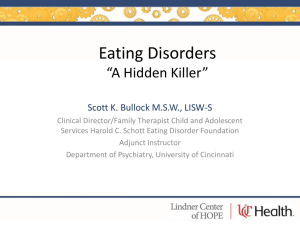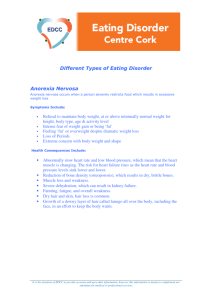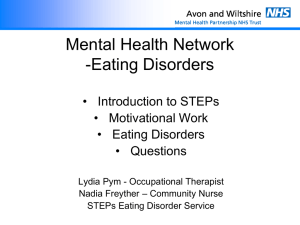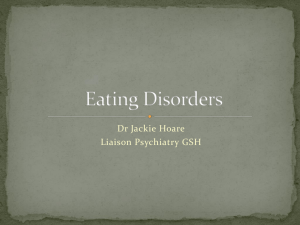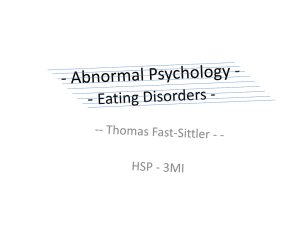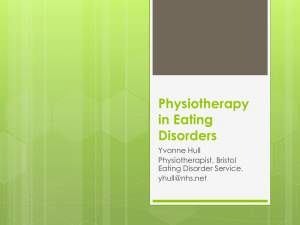Diagnosis and Management of Eating Disorders - UCLA Med-Peds
advertisement
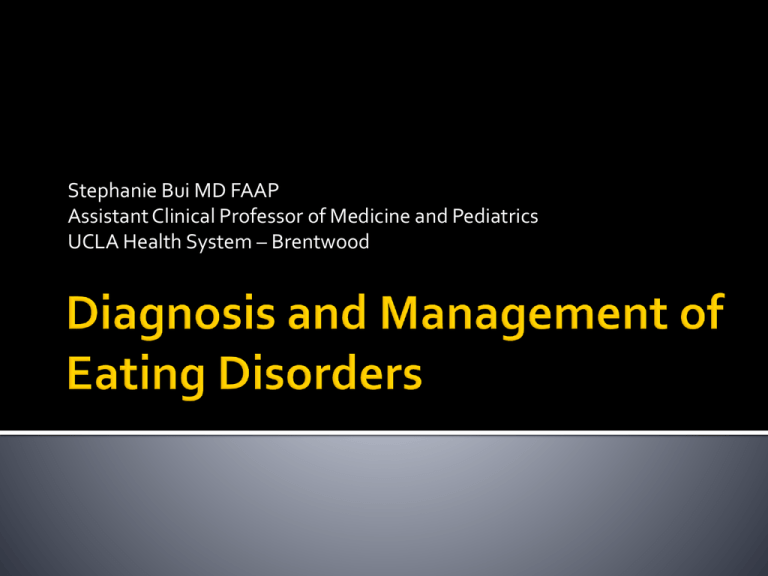
Stephanie Bui MD FAAP Assistant Clinical Professor of Medicine and Pediatrics UCLA Health System – Brentwood K.P. is a 17 year old female presenting to your office for “irregular periods”. Had been seen 8 months prior for a well visit. At that time height was 65 inches, weight 140 lbs (BMI 22.6). Menarche age 13, having normal menstrual cycles every 28-32 days Today height is 65 inches, weight 115 lbs (BMI 18.6). Last period was 3 months previously Patient denies sexual activity Patient says that she has just been “getting healthy” by cutting out snacks Patient says she started exercising as well to “get healthy” Is very evasive and defensive when asked how much she eats/how much exercises Mom asks to see you outside of the room Has noticed that K.P. is eating less meals with the family Has noticed a weight loss (unsure how much) Scale is now moved from bathroom to K.Ps room Mom has not been able to discuss this with K.P. as patient gets defensive Worried that K.P. has an eating disorder As stated – weight 115 lbs. Blood pressure 100/60. Heart rate 50. Temp 96.7 HEENT – Lanugo noted on face Neck – Thyroid – normal size, no masses CV: Bradycardia Breasts: Tanner 4, Pubic Hair Tanner 4 Abdomen: Soft/non tender/no masses Extremities: Cool fingertips and Toes What labs do you want? Urine Pregnancy test – negative CBC – WBC 3.1 otherwise normal Chem 10 – Normal Prolactin – Normal TSH – Normal FSH – 2.0 LH – 2.0 Estradiol <30 EKG – Sinus bradycardia at 50 BPM otherwise normal You tell K.P that her lack of periods is likely due to her weight loss You begin to discuss healthy ways of gaining weight, she storms out of the room and says “No Way I’m doing that – I’m fine the way I am” • • • • • • DSM IV-TR Criteria A. Refusal to maintain body weight at or above a minimally normal weight for age and height B. Intense fear of gaining weight or becoming fat, even though underweight Disturbance in the way in which one’s body weight of shape is experienced Amennorhea (in post menarchal females) – absence of at least 3 menstrual periods Type – Restricting Type or Binge-Eating/purging Type Genetic: First degree relative 3x risk Biologic: neurotransmitter abnormalities Sociocultural: obsession with thinness Psychological Low self esteem Conflict about identity, sexuality Obsessive-compulsive 40% history of abuse, being teased Family: enmeshed, overprotective Sports: gymnastics, ice skating ballet • • • • • • Prevalence – Estimated at 1% 90-95% are female Bimodal peaks of onset at ages 13-14 and 1718 Prepubertal may be associated with more severe profile Adolescent onset associated with better prognosis that prepubertal and adult onset 30% of patients were obese Determine Level of Care: Medically Unstable: medical hospital ▪ Heart rate <40, glucose < 60 mg/dl, potassium <3 mEq/l, orthostatic hypotension Psych Unstable: psych hospital Med/Psych stable: ▪ <70% IBW: Inpatient ▪ 70-85% IBW: Partial/Day treatment ▪ >85%: Outpatient Create treatment team Therapist: individual and family Nutritionist Medical provider Psychiatrist Coordination between all providers is KEY Start with therapeutic alliance School – Consider reduced schedule Exercise: limit activities, team sports, gym Amennorhea: consider OCP >6-12 months Calcium 1200-1500 mg Vitamin D 400-800 IU Dexa Scan if no menses > 6 months Standardized tables Premorbid weight Weight at which patient had last period Progressive weight goals Weight at which patient feels safe and healthy May need to postpone discussion Close monitoring: every 1-2 weeks Standardized weights: gown, empty bladder Weight gain: ½-1 lb per week If faster risk refeeding syndrome Ask patient if they want to know weight Avoid comments about weight During treatment constantly assess: Resistance, denial, non-compliance, deception Depression, anxiety Purging activities Treat psychiatric co-morbities Cardiac: Arrhythmias, prolonged QT, heart failure, pericardial effusions Neurologic: cerebral atrophy Endocrine:Osteoporosis Renal: renal failure, nephrolithiasis GI: gastric dysmotility Dental: enamel erosions Initial visit – after coaxing back into room, you explain your concerns about health She reluctantly agrees to see a nutritionist, refuses to see a therapist Follow-up one week later, weight is down 2 pounds – refused to implement changes suggested by nutritionist Admitted to day treatment program < 50% achieve full recovery Predictors of recovery: higher body weight at intake, shorter duration of intake episode, and atypical features 1/3 improve with lingering symptoms 1/5 remain chronically ill Mortality Mortality rate is 12x higher than that for age matched women 24% of deaths due to suicide K.P. presents to your office 5 years since initial diagnosis of anorexia nervosa – since that time, she has had one inpatient admission and 3 partial hospitalizations – last at age 19. Her weight has been stable at 135 for the past 2 years On exam, you noticed parotid enlargement, and scars on her knuckles Recurrent episodes of binge eating Recurrent inappropriate compensatory behaviors in order to prevent weight gain (self induced vomiting, misuse of laxatives, diuretics, enemas or other medications, fasting, excessive exercise) At least 2 episodes of binge eating per week for 3 months Two types: Purging Non purging Similar to anorexia nervosa Borderline personality disorder Impulse Control Perfectionism Disturbances in family function History of sexual abuse Lifetime Prevalence 1%-4.2% 90-95% femaile Onset later than in anorexia nervosa Less common in African Americans 50% of patients with anorexia nervosa will migrate to Bulimia Nervosa Eating and Body image questions Questions about binge eating Frequency, amounts Triggers – specific foods, situations, feeling Facillitators Questions about purging Frequency, techniques After purge, how do you feel? Dental Care Vomited Blood, reflux symptoms Determine Level of Care Create treatment team Focus on the binge, not the purge Dental Care Rinse teeth immediately, don’t brush for 30 minutes Sensitive toothpaste Medications SSRIs – most studied is fluoxetine 60 mgs/day Bupropion – black box warning re: seizures Related to purging activity Dental: erosion, false teeth GI: esophageal tears, cathartic colon, GERD Metabolic: electrolye imbalance, dehydration Mortality – low 50% will achieve full recovery at 5 – 12 years 1/3 of these will go on to relapse Eating Disorder “not otherwise specified” Binge eating Disorder Disordered Eating 21 year old female, no past medical history Height 5 ft 8 lb, weight 140 lbs On routine history – exercises 7 days/week for 60 minutes – because “if I don’t I feel fat” Counts calories Eats same foods every day Weighs herself daily Physical exam normal, Labs normal When thoughts about your body and/or eating interfere with your life “If I were just 5 lbs thinner I would be happy” “If I were thinner, then people would like me more” “ I feel so fat; I am so fat; I will eat today and start my diet tomorrow” Eating rituals – same food, same schedule Cutting out fat, favorite foods Weighing self a lot Excessive exercising Eating only if “good” Do you make yourself Sick “purge” because you feel uncomfortalby full? Do you worry that you have lost Control Have you recently lost more than 14 lbs (One Stone) in a 3 month period Do you think you are too Fat Would you say that Food dominates your life 15 year old male new patient presented to office for “anorexia nervosa” Recently discharged from inpatient eating disorder facility Previous to his admission there, had lost 15 pounds with decreased intake. Vague complaints of abdominal pain On review of labwork, had microcytic anemia prior to admission to eating disorder facility Gained weight only with tube feeds in hospital (was refusing po) Repeat labs after hospitalization – persistent microcytic anemia, low Fe levels, elevated ESR Dad with “colitis” Bottom line – severe Crohn’s disease Ultimately required ileocecal resection. If your patient says “I feel fat”, it is code for I feel sad I feel angry I feel stupid Don’t dismiss the feeling, normalize it Emphasize health and fitness for patient and family People are different shapes and sizes Everyone can try to be healthy, fit and heave healthy body image Routinely ask about body image Set follow up appointments For families Be Direct: “I am worried about you” Be prepared: show direct evidence Be Firm Don’t bribe or monitor Get help – Earlier the diagnosis, better the prognosis

